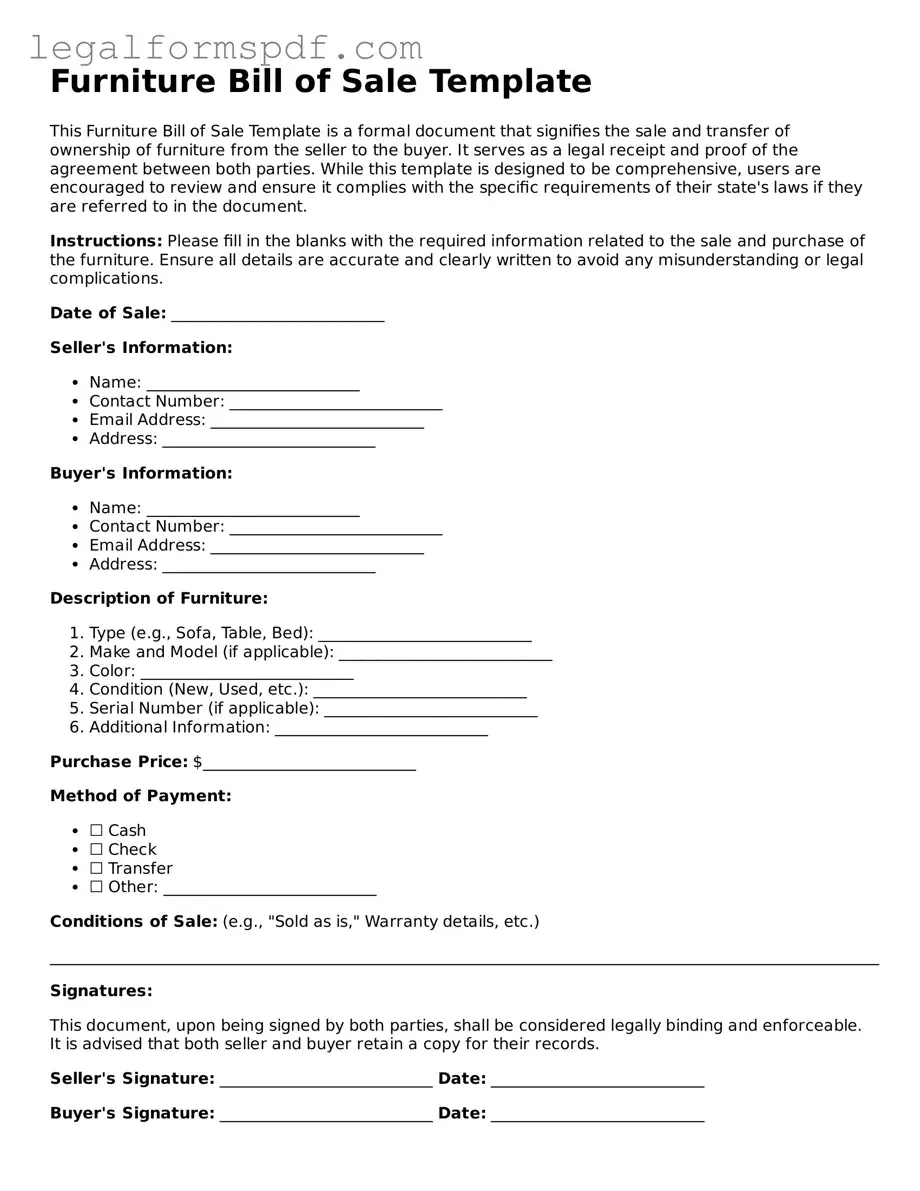What is a Furniture Bill of Sale?
A Furniture Bill of Sale is a written document that records the sale of furniture from one party, the seller, to another, the buyer. It serves as a proof of transaction and includes essential details such as the description of the furniture, the sale price, and the date of sale. This document is useful for both personal record-keeping and legal purposes should any disputes arise regarding the transaction.
Why do I need a Furniture Bill of Sale?
Having a Furniture Bill of Sale is important because it officially documents the transaction, providing evidence that the furniture has legally changed hands. For the buyer, it serves as a receipt and proof of ownership, while for the seller, it can help avoid any future disputes over the item's condition or ownership. Additionally, this document can be crucial for insurance purposes or when dealing with estate matters.
What information should be included in a Furniture Bill of Sale?
A comprehensive Furniture Bill of Sale should include the names and addresses of the buyer and seller, a detailed description of the furniture (including make, model, condition, and any identifying marks), the sale price, the date of sale, and payment details. It's also advisable to include signatures of both parties and, if possible, a witness to the transaction.
Do I need to notarize my Furniture Bill of Sale?
In most cases, notarization of a Furniture Bill of Sale is not a requirement for it to be legally valid. However, having it notarized can add an extra layer of authenticity and may be beneficial in ensuring the document is acknowledged as legally binding by all parties involved. It's always a good idea to check local laws and regulations, as requirements can vary by jurisdiction.
Can I create a Furniture Bill of Sale myself?
Yes, it is certainly possible to create a Furniture Bill of Sale by yourself. There are many templates available online that can serve as a guide. However, it's important to ensure that the document includes all necessary information and meets any specific requirements your local jurisdiction may have. For more complex transactions or to guarantee legal validity, you may want to consult with a legal professional.
Is a verbal agreement enough when selling furniture?
While verbal agreements can be legally binding in some cases, relying solely on one when selling furniture is not advisable. Without written documentation, it can be extremely difficult to prove the terms of the agreement or even the fact that the sale took place, should any disputes arise. A written Furniture Bill of Sale provides a clear, enforceable record of the transaction.
What should I do after completing a Furniture Bill of Sale?
After completing a Furniture Bill of Sale, both parties should keep a copy of the signed document for their records. The seller should ensure that the furniture is delivered to the buyer, and any agreed-upon terms of the sale are fulfilled. As a buyer, it's also important to update any insurance policies or homeowners' records to reflect the new acquisition.
Can I use a Furniture Bill of Sale for used furniture?
Yes, a Furniture Bill of Sale can be used for both new and used furniture. In fact, it's especially important to use one when buying or selling used furniture, as it can help document the item's condition at the time of sale and prevent future disputes about its value or state.
Does a Furniture Bill of Sale need to be witnessed?
While not always a requirement, having a third-party witness sign the Furniture Bill of Sale can lend additional credibility to the document. A witness can help verify that the transaction indeed took place and that both parties agreed to the terms listed in the bill of sale. Again, specific requirements may vary by jurisdiction, so it's beneficial to check local laws.
Can a Furniture Bill of Sale be used as tax documentation?
In some instances, a Furniture Bill of Sale can be used for tax purposes, such as deducing the purchase of business-related furniture or claiming a loss from the sale of used furniture. It's advisable to consult with a tax professional to understand how the document can be used in your individual or business tax return, as tax regulations can be complex and vary widely.
